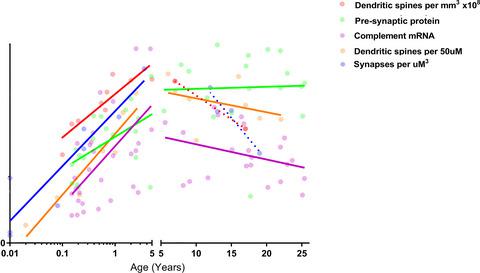当前位置:
X-MOL 学术
›
J. Neurochem.
›
论文详情
Our official English website, www.x-mol.net, welcomes your
feedback! (Note: you will need to create a separate account there.)
Trajectory of change in brain complement factors from neonatal to young adult humans
Journal of Neurochemistry ( IF 4.2 ) Pub Date : 2020-11-15 , DOI: 10.1111/jnc.15241 Rachel E H Sager 1 , Adam K Walker 2, 3, 4 , Frank Middleton 1 , Kate Robinson 5 , Maree J Webster 6 , Cynthia Shannon Weickert 1, 3, 5
Journal of Neurochemistry ( IF 4.2 ) Pub Date : 2020-11-15 , DOI: 10.1111/jnc.15241 Rachel E H Sager 1 , Adam K Walker 2, 3, 4 , Frank Middleton 1 , Kate Robinson 5 , Maree J Webster 6 , Cynthia Shannon Weickert 1, 3, 5
Affiliation

|
Immune system components also regulate synapse formation and refinement in neurodevelopment. The complement pathway, associated with cell lysis and phagocytosis, is implicated in synaptic elimination. Aberrant adolescent synaptic pruning may underpin schizophrenia onset; thus, changes in cortical complement activity during human development are of major interest. Complement is genetically linked to schizophrenia via increased C4 copy number variants, but the developmental trajectory of complement expression in the human brain is undetermined. As complement increases during periods of active synaptic engulfment in rodents, we hypothesized that complement expression would increase during postnatal development in humans, particularly during adolescence. Using human postmortem prefrontal cortex, we observed that complement activator (C1QB and C3) transcripts peaked in early neurodevelopment, and were highest in toddlers, declining in teenagers (all ANCOVAs between F = 2.41 –3.325, p = .01–0.05). We found that C4 protein was higher at 1–5 years (H = 16.378, p = .012), whereas C3 protein levels were unchanged with age. The microglial complement receptor subunit CD11b increased in mRNA early in life and peaked in the toddler brain (ANCOVA: pH, F = 4.186, p = .003). Complement inhibitors (CD46 and CD55) increased at school age, but failed to decrease like complement activators (both ANCOVAs, F > 4.4, p < .01). These data suggest the activation of complement in the human prefrontal cortex occurs between 1 and 5 years. We did not find evidence of induction of complement factors during adolescence and instead found increased or sustained levels of complement inhibitor mRNA at maturation. Dysregulation of these typical patterns of complement may predispose the brain to neurodevelopmental disorders such as autism or schizophrenia.
中文翻译:

从新生儿到年轻人的大脑补体因子变化轨迹
免疫系统成分还调节神经发育中突触的形成和完善。与细胞裂解和吞噬作用相关的补体途径与突触消除有关。青少年异常突触修剪可能是精神分裂症发作的基础。因此,在人类发育过程中皮质补体活性的变化引起了人们的极大兴趣。补体通过增加的C4拷贝数变异与精神分裂症遗传相关,但人脑中补体表达的发展轨迹尚未确定。随着啮齿动物主动突触吞噬期间补体的增加,我们假设补体表达在人的出生后发育过程中会增加,尤其是在青春期。使用人类尸体前额叶皮层,F = 2.41 – 3.325,p = 0.01 – 0.05)。我们发现C4蛋白在1-5年时较高(H = 16.378,p = .012),而C3蛋白水平却随着年龄的增长而保持不变。小胶质补体受体亚基CD11b在生命早期就增加了mRNA的表达,并在蹒跚学步的大脑中达到高峰(ANCOVA:pH,F = 4.186,p = 0.003)。补体抑制剂(CD46和CD55)在学龄期增加,但未能像补体激活剂一样下降(均为ANCOVA,F > 4.4,p <.01)。这些数据表明人类前额叶皮层中补体的激活发生在1至5年之间。我们没有找到在青春期期间诱导补体因子的证据,而是发现了成熟时补体抑制剂mRNA的升高或持续水平。这些典型补体模式的失调可能使大脑易患神经发育障碍,例如自闭症或精神分裂症。
更新日期:2020-11-15
中文翻译:

从新生儿到年轻人的大脑补体因子变化轨迹
免疫系统成分还调节神经发育中突触的形成和完善。与细胞裂解和吞噬作用相关的补体途径与突触消除有关。青少年异常突触修剪可能是精神分裂症发作的基础。因此,在人类发育过程中皮质补体活性的变化引起了人们的极大兴趣。补体通过增加的C4拷贝数变异与精神分裂症遗传相关,但人脑中补体表达的发展轨迹尚未确定。随着啮齿动物主动突触吞噬期间补体的增加,我们假设补体表达在人的出生后发育过程中会增加,尤其是在青春期。使用人类尸体前额叶皮层,F = 2.41 – 3.325,p = 0.01 – 0.05)。我们发现C4蛋白在1-5年时较高(H = 16.378,p = .012),而C3蛋白水平却随着年龄的增长而保持不变。小胶质补体受体亚基CD11b在生命早期就增加了mRNA的表达,并在蹒跚学步的大脑中达到高峰(ANCOVA:pH,F = 4.186,p = 0.003)。补体抑制剂(CD46和CD55)在学龄期增加,但未能像补体激活剂一样下降(均为ANCOVA,F > 4.4,p <.01)。这些数据表明人类前额叶皮层中补体的激活发生在1至5年之间。我们没有找到在青春期期间诱导补体因子的证据,而是发现了成熟时补体抑制剂mRNA的升高或持续水平。这些典型补体模式的失调可能使大脑易患神经发育障碍,例如自闭症或精神分裂症。











































 京公网安备 11010802027423号
京公网安备 11010802027423号